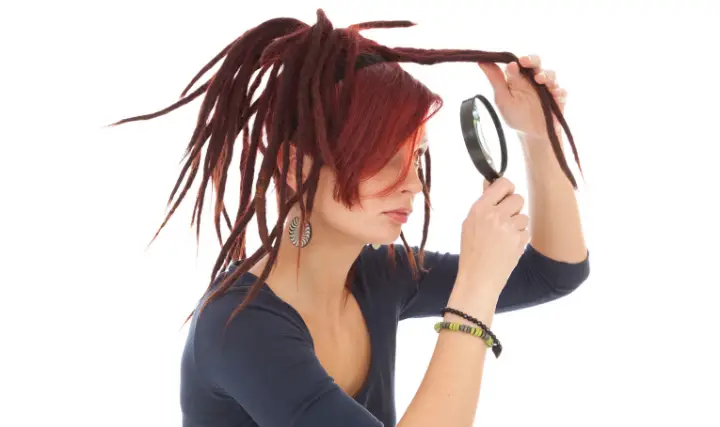Unwashed, matted, and smelly hair – that’s what many people wrongly associate with dreadlocks. Sure, there may be one or two people who don’t wash their dreads, but in my experience, that tends to be the exception.
The big advantage is that you have to wash dreads less often than open hair because they don’t look greasy as quickly.
Although it takes a little time for the scalp to get used to the longer intervals, then, it is often enough to clean them properly every 4 to 8 weeks.
But this also varies, of course, depending on how quickly your scalp regreases.
Read: How Often Should You Retwist Your dreadlocks

Washing Dreadlocks: Things You Should know.
- Do not use conditioning shampoos or conditioners with silicone.
- Especially in the beginning it can lead to the fact that the not yet so well matted strands dissolve again.
- Washing dreadlocks takes longer.
- Yes, it takes longer than washing your hair normally. On the one hand, it takes a little more time until you have properly soaped the scalp and on the other hand, washing it out is more time-consuming.
- Lather up the shampoo in your hands before you put it into the dreads.
- To avoid having a large residue in your dreads, you should lather up your shampoo in your hands beforehand and only then run it into your felted curls. This will leave less soap residue in your hair.
- It takes forever to dry.
- You can almost think of dreadlocks as a sponge. They literally soak up the water when you wash them. That’s why it’s important that you wring them out properly afterward. And yet, depending on the thickness, drying can take between 6 and 12 hours. A drying hood can help here. Personally, I always wash them in the morning, then I don’t have to go to bed with wet worms.
Re-felting the roots
From time to time, you’re going to have to take care of your roots if you like it neat on your head.
The dreads actually grow out and most of us aren’t lucky enough to have the roots re-felt on their own.
Accordingly, a little help is needed. Again, there are several methods:
Pulling the dread through the roots
You take a dread and pull it through the open roots. On the one hand, this method is super easy, but on the other hand, the dread can split quickly if you don’t do it right.
Only a few hairs are pulled from the base to the side to create a hole through which the dread is then pulled.
Then repeat on the opposite side the other way around and then front and back until the strand is firmly back at the roots.
Personally, I do not like this method so much because it always looks quickly like braided from the structure.
Also, in my opinion, the dreads become uncomfortably hard and knobby.
Tighten-Roots
In my opinion, the most effective method for re-felting the roots is Tighten-Roots.
Here you take the dread about 1 – 2 cm above the roots between your index and middle finger, like a cigarette. Now you press it on the head and start with circular movements going in one direction.
After a short time, you will notice how the hair tangles at the base.
Do this until the roots are tight. Then, depending on the situation, crochet through briefly and you’re done.
Just be careful that no loose hairs get into the roots, which do not belong there.
Poke method
With the poke method, you simply take your crochet hook and try to work the loose hairs back into the dread by poking at the base.
Here you should work carefully, because it can happen that you work some hairs into the dread that do not belong in the base. On the other hand, you could thin out the dread.
Most providers for the creation of dreads also offer maintenance appointments. It is worthwhile to have all dreadlocks worked through once a year.
Especially at the back of the head you often have places that you don’t see yourself.
The right crochet hook
Of course, you need a suitable crochet hook for your dreads to be able to crochet them properly. I personally have two – one in the size 0.75 mm and one in the size 0.5 mm.
It’s best to buy some with a firm grip, it makes crocheting much easier. And be careful, nothing is more unpleasant than the hook of such a fine needle in your finger.
Tip: Never use a felting needle. The risk of tearing off the dreadlock is far too great.
When crocheting, less is often more. I know from experience that especially in the beginning you tend to crochet your dreads to death, because you think that every hair sticking out is a potential danger for the development of the felt curls.
But if you crochet too much, your dreads will become extremely hard and you may end up not coming through at all.
So don’t overdo it and just let them develop.

How to crochet dreads correctly?
There is actually no right and no wrong. However, I can give you a few tips that will make it easier for you, especially in the beginning.
Again, there are two different methods.
1) Simply take the dread between your index finger and thumb.
Then pass the crochet hook through the dread between the two fingers, pull back the hairs that are sticking out to the half of the dread and continue until there are no more small hairs to be seen.
Proceed in this way until nothing is sticking out at the end.
2) If you have several hairs sticking out of the felt curl, you can also tangle them with your fingers, then run the crochet hook through the dread, wrap the tangled strands around the hook and pull it back halfway.
Now twist the hook so that the strand slides off the crochet hook.
Recipe for deep cleaning
As a fresh dreadhead, you’ll eventually stumble upon the topic of deep cleaning.
It doesn’t stay away; no matter how well you take care of your felted locks, there will be soap residue as well as dust and lint left behind in your dreads.
Since it can be worthwhile to clean them now and then (I do it 1x per year) reasonable.
The recipe for deep cleaning comes from experts, and it works great.
You will need:
- 30 gr. Baking soda
- 1 tbsp. sea salt
- 2 tbsp. lemon juice
- 60 ml apple cider vinegar
How it works:
- Fill a large bowl or the sink with warm water. Now add the sea salt until it has dissolved. Then add the baking soda, lemon juice, and finally the vinegar.
- Now hang your dreadlocks in the mixture for about 15 minutes up to the roots. After that, rinse your hair well and wash it as needed (but it doesn’t have to be).
- As you’ll see from the broth that’s left behind, it’s well worth it. The ingredients make a sodium hydroxide solution that has a stronger cleaning effect than classic washing.
“Dreadlocks must be cut off”.
Again and again you hear that you can only cut off the matted hair and then you have to walk around as a woman with a bald head or very short hair.
This is what keeps many from getting dreadlocks done. However, this is simply not true. There is another way to get rid of dreadlocks:
You can comb out dreads.
However, I have to say one thing right away: combing them out is a tedious job that doesn’t happen overnight. In the end, it can be said that combing out dreadlocks usually takes just as long as creating them.
Dreadlocks Combing out dreads, this is how it works
To do this, it is recommended to wash your hair for some time with conditioning shampoo, conditioner and nourishing oils.
This will soften your dreads a bit and they may come loose a little.
If it is then so far, it goes easiest with a fork, knitting needle, or similar. Now you have to comb your dreads slowly from the bottom to the top.
Make sure that you do not pull out too many hairs. Work your way up mm by mm and pull only a few strands down with your tool.
Tip: If you cut off a part of the broken tips, you will have to comb out less.
Be sure to give your hair plenty of care after combing it out. And don’t worry, you will lose some hair and when I say some, I really mean some.
But that’s because people naturally lose a certain amount of hair per day. With dreadlocks, it’s not noticeable because the loose hairs just felt into the strands. When you comb them out, you lose them naturally.
Fake Dreads
In addition to real dreads, there are of course also those that do not last forever.
These can be made for a party night or a few weeks in the hair and thus test out whether you like it and how you get along.
So if you are not sure, fake dreads would be a great way to try out exactly that.
Whether you prefer faux or human hair is up to you.
Weaving them in is incredibly easy. You divide your hair just like you would for real dreads. Then you connect your divided hair with the fake dreads and the voluminous hair is ready.